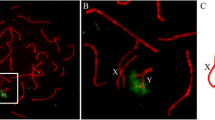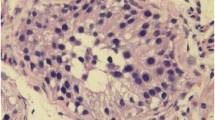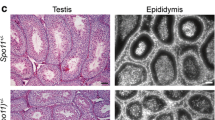Abstract
In Feulgen sqaushes from control and EDTA pretreated seminiferous tubules of white mice, association of non-homologous chromosomes has been observed in pachytene, diplotene and in secondary spermatocyte nuclei. Without pretreatment, such associations are intimate whereas, after pretreatment, bridges between the bivalents. It is conjectured that:
-
1)
the observed centers ofnon-homologous association might function inhomologous pairing and in coordinating spiralization within bivalents and that
-
2)
ordered geometrical placement of bivalents with respect to each other and in relation to the whole nucleus might occur in all stages of spermatogenesis.
Similar content being viewed by others
References
Grell, Rhoda (1962). A new model for secondary non-disjunction: the role of distributive pairing.Genetics 47: 1737–1754.
Grell, Rhoda (1964). Chromosome size at distributive pairing inDrosophila melanogaster females.Genetics 50: 151–166.
Grell, Rhoda &J. Valencia (1964). Distributive pairing and aneuploidy in man.Science 145: 66–67.
Hayden, M. (1925). Karyosphere formation and synapsis in the beetlePhanaeus.J. morph. 40: 261–298.
Heitz, E. (1928). Das Heterochromatin der Moose I.Jhbr. Wiss. Bot. 69: 762–818.
Heitz, E. (1933). Über totale und partielle somatische Heteropyknose, sowie structurelle Geschlechtschromosomen beiDrosophila funebris. (Cytologische Untersuchungen an DDipteren II)Ztschr. Zellf. mikr. Anat. 19: 720–742.
Heitz, E. (1934). Über α-und β-Heterochromatin sowie Konstanz und Bau der Chromomeren beiDrosophila.Biol. Zentralbl. 54: 588–609.
Hughes-Schrader, Sally (1948). Cytology of coccids (Coccoidea-Homoptera).Adv. Genet. 2: 127–203.
Hustinx, T. (1965). D-D and D-21 translocation families in man (personal communication).
Koller, P. (1944). Segmental interchange in mice.Genetics 29: 247–263.
Lejeune, J. (1965). Origin and significance of autosomal abnormalities. Genetics Today,Proc. XI Internat'l. Cong. Genetics, 1963. 3: 823–831.
Lima-de-Faria, A. &L. Reitalu (1963). Heterochromatin in human male leukocytes.J. Cell Biol..16: 315–322.
Matsuura, H. &M. Kurabayashi (1951). Chromosome studies onTrillium kamschaticum Pall. and its allies. XXIV. The association of kinetochores or non-homologous chromosomes at meiosis.Chromosoma 4: 273–283.
Matthey, R. (1963). Polymorphisme chromosomique intraspecifique et intraindividuel chezAcomys minous Bate (mammalia-rodentia-muridae), étude cytologiqueAcomys minous ♂ × Acomys cahirinus ♀. Le méchanisme des fusions centriques.Chromosoma 14: 468–497.
McClintock, Barbara (1933). The association of non-homologous parts of chromosomes in the mid-prophase of meiosis inZea mays.Zeit. Zellforsch. mikr. Anat. 19: 191–237.
Nagao, S. &K. Sakai (1939). Association of chromosomes inChelidonium majus L.Jap. J. Genetics 15: 23–28.
Norby, E. (1965). Metaphase orientation of chromosomes in primary spermatocytes of cats.Genetics 52: 463.
Novitski, E. (1964). An alternative to the distributive pairing hypothesis inDrosophila.Genetics 50: 1449–1451.
Ohno, S., J. Trujillo, W. Kaplan &R. Kinosita (1961). Nucleolus-organizers in the causation of chromosomal anomalies in man.Lancet i: 123–125.
Ohno, S., L. Christian &C. Stenius (1963). Significance in mammalian oögenesis of the non-homologous association of bivalents.Exp. Cell Res. 32: 590–621.
Ohno, S. &J. Smith (1964). Role of fetal follicular cells in meiosis of mammalian oöcytes.Cytogenetics 3: 324–333.
Painter, T. (1935). Morphology of the third chromosome in the salivary gland ofDrosophila melanogaster and a new cytological map of this element.Genetics 20: 301–326.
Painter, T. &W. Stone (1935). Chromosome fusion and speciation inDrosophila.Genetics 20: 327–341.
Sax, K. (1931). Chromosome ring formation inRhoeo discolor.Cytologia 3: 36–53.
Schrader, F. (1923). A study of chromosomes in three species ofPseudococcus.Arch. Zellforsch. 17: 45–62.
Schrader, F. (1940). The formation of tetrads and the meiotic mitoses in the maleRhytidolomia senilis Say (Hemiptera-Heteroptera).J. Morph. 67: 123–141.
Schrader, F. (1941). Heteropycnosis and non-homologous association of chromosomes inEdessa irrorata (Hemiptera-Heteroptera).J. Morph. 69: 587–607.
Schultz, J. &P. St. Lawrence (1949). A cytological basis for a map of the nucleolar chromosome in man.J. Hered. 40: 30–38.
Shult, E. &C. Lindegren (1957). Orthoorientation: a new tool for genetical analysis.Genetica 29: 58–82.
Simmonds, N. (1945). Meiosis in tropicalRhoeo discolor.Nature (London)155: 731.
Slack, H. (1938). The association of non-homologous chromosomes in the Corixidae (Hemiptera-Heteroptera).Proc. Roy. Soc. Edinburgh 58: 192–212.
Smith, E. (1965). Preferential segregation from a trivalent inHaplopappus validus. Canad. J. of Gen. and Cytol.7: 484–490.
Tan, C. (1935). Salivary glands in the two races ofDrosophila pseudo-obscura.Genetics 20: 392–402.
Wallace, Margaret (1958). Evidence for a new genetic phenomenon.Proc. Roy. Phil. Soc. (London) B.241: 211–251.
Wallace, Margaret (1959). An experimental test of the hypothesis of affinity.Genetica 29: 243–255.
Walters, J. (1952). Heteromorphic chromosome pairs inPaeonia californica.Am. J. Bot. 39: 145–151.
Walters, J. (1956). Spontaneous meiotic chromosome breakage in natural populations ofPaeonia californica.Am. J. Bot. 43: 342–354.
Walters, M. &D. Gerstel (1948). A cytological investigation of a tetraploidRhoeo discolor.Am. J. Bot. 35: 141–150.
Yamashita, K. (1951). Studies on X-ray induced reciprocal translocations in Einkorn wheats III. A newly synthesized ring of 14 chromosomes in a complex heterozygote,Aegilopoides monococcum.Cytologia 16: 164–176.
Yerganian, G. (1963). Chromosome cytology and medical anomalies in radiation-induced chromosome aberrations, Ed.S. Wolff. P. 237–270. Columbia University Press, New York.
Yerganian, G. (1965). End-to-end orientation of chromosomes in the Armenian hamster (personal communication).
References
Bauer, H. (1936). Structure and arrangement of salivary gland chromosomes inDrosophila species.Proc. Nat. Acad. Sci. 22: 216–222.
Brown, S. (1959). Lecanoid chromosome behavior in three more families of the coccoidea (Homoptera).Chromosoma 10: 278–300.
Burnham, C. (1950). Chromosome segregation in translocations involving chromosomes in maize.Genetics 35: 446–481.
Burham, C. (1956). Chromosomal interchanges in plants.Bot. Rev. 22: 419–552.
Burnham, C., F. White &R. Livers (1954). Chromosome interchanges in barley.Cytologia 19: 191–202.
Callan, H. &L. Lloyd (1960). Lampbrush chromosomes of crested newts,Triturus cristatus (Laurenti).Phil. Trans. Roy. Soc., London, B.243: 135–219.
Chandley, Ann (1965). Application of the “distributive pairing” hypothesis to problems of segregation in translocation heterozygotes ofDrosophila melanogaster.Genetics 52: 247–258.
Cleland, R. (1923). Chromosome arrangements during meiosis in certain Oenotheras.Am. Nat. 57: 562–566.
Cleland, R. (1929). Meiosis in the pollen mother cells of the Oenotheras and its probable bearing on certain genetical problems.Proc. Internat'l Cong. Plant Sci. 1: 317–331.
Cleland, R. (1932). Further data upon circle formation inOenothera, its cause and its genetical effect.Genetics 17: 572–602.
Cleland, R. (1957). Chromosome structure inOenothera and its effect on evolution of the genus.Cytologia Suppl., Proc. Internat'l. Genetics Symp., 1956: 5–19.
Darlington, C. (1929). Ring formation inOenothera and other genera.J. Genetics 20: 345–363.
Darlington, C. &A. Gairdner (1937). The variation system inCampanula persicifolia.J. Genetics 35: 97–128.
Douglas, L. (1965). Evidence for tandem arrangement of chromosomal elements in spermatid nuclei of the Chinese hamster.Genetica 36: 59–64.
Eberle, P. (1963). Meiotische Chromosomen des Mannes.Klinische Wochenschrift 41: 848–856.
Eberle, P. (1966). Die Chromosomenstruktur des Menschen in Mitosis und Meiosis. 261 pp. Gustav Fischer Verlag, Stuttgart.
Emerson, S. (1932). Chromosome rings inOenothera, Drosophila and maize.Proc. Nat. Acad. Sci. 18: 630–632.
Ferguson-Smith, M. &S. Handmaker (1961). Observations on satellited human chromosomes.Lancet i: 638–640.
Geitler, L. (1935). Neueste Forschungen über den Chromosomenbau.Der Züchter 1: 294–304.
Gregoire, V. &J. Berghs (1904). La figure achromatique dans lePellia epiphylla.La Cellule 21: 193–238.
Author information
Authors and Affiliations
Rights and permissions
About this article
Cite this article
Douglas, L.T. Meiosis, I: Association of non-homologous bivalents during spermatogenesis in white mice. Genetica 37, 466–480 (1966). https://doi.org/10.1007/BF01547149
Received:
Issue Date:
DOI: https://doi.org/10.1007/BF01547149




